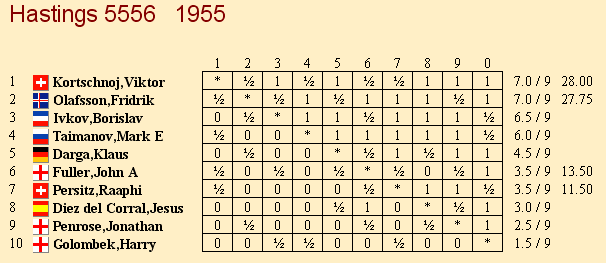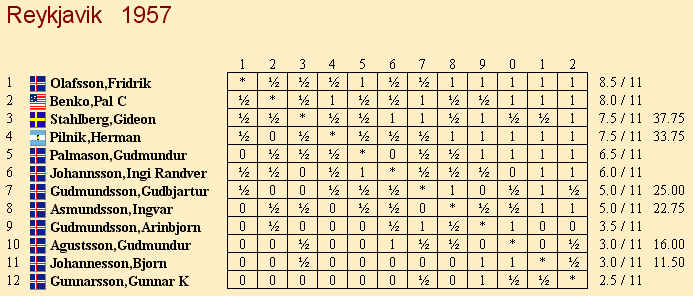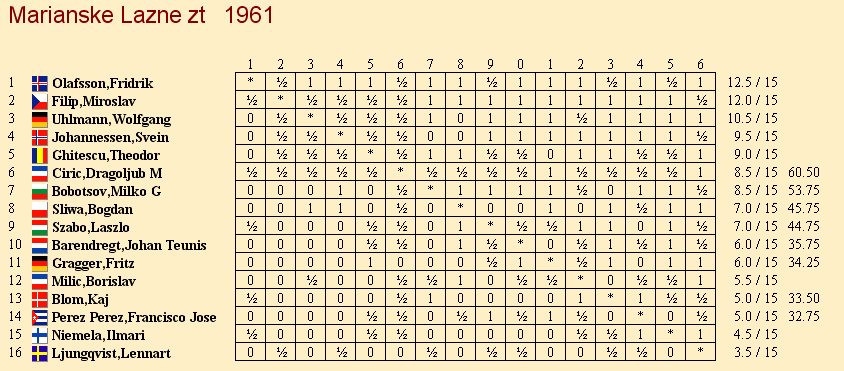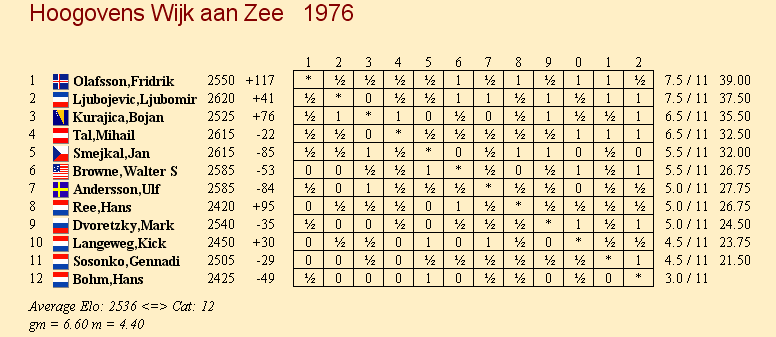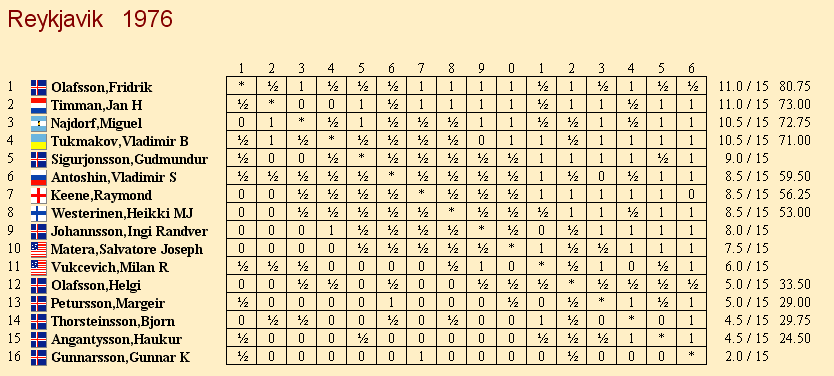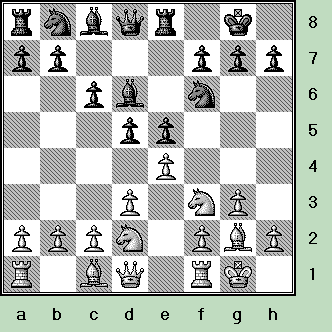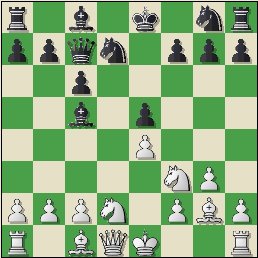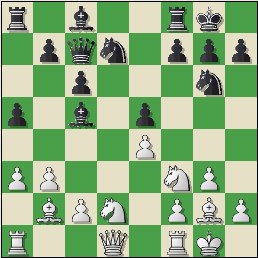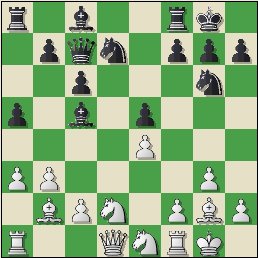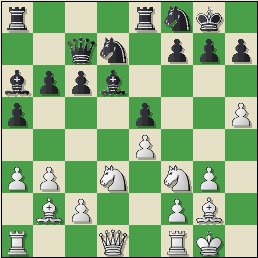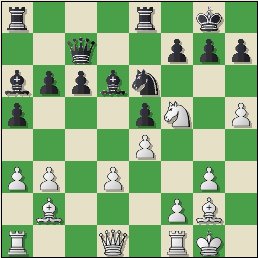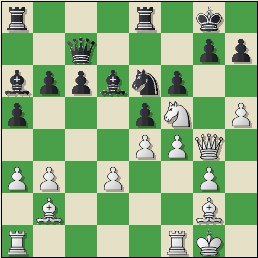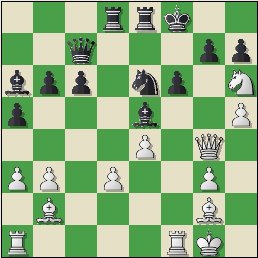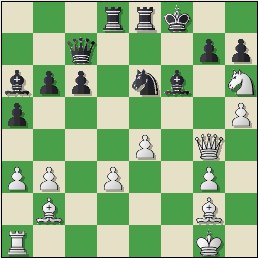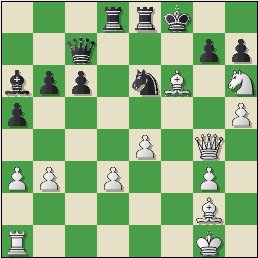All
the |
(Navigation bar
directly below.)
*******
© A.J. Goldsby, 2015.
(All rights reserved.)
****************
Click HERE
to see my
Chess Items.
****************
****************
Buy a book
from Amazon.com
(And help me out as well!)
****************
Click HERE
...
to see a list of the businesses that help to sponsor all of
my chess efforts.
A great game of chess ... from GM Fridrik Olafsson.
I first saw this game on-line at the "Chess-Games" website. After just a few minutes, I knew that I had to analyze it and post it on my website. However, there were many setbacks. I have had MULTIPLE computer crashes and problems since about the middle of May, 2010. My copy of Windows (XP) became corrupted and I had to RE-FORMAT my hard drive and have Windows re-loaded. (This also entailed having to re-install all of my software!) I had memory chips go bad, I had a virus ... at one point, (end of June 2010 and early July); my PC was in the shop for nearly two weeks, I did not think I was ever going to get it back. So I apologize for any problems or delays, but these could not be helped.
I want this game to serve as a permanent tribute to this player ... my own little "fan page" for this player. While I have tried to be as factually accurate as possible, I purposely chose things - like his first picture, here - to serve as a reminder of this player when he was at (or near) to his best playing days.
Two pictures of the GM, (the one on the left - was when he was younger); ... and a few cross-tables of his better events.
|
|
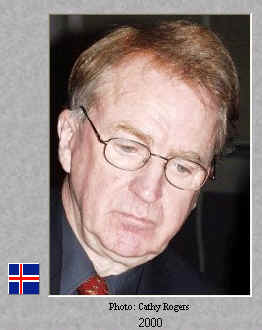 |
**********
|
|
**********
|
|
**********
|
|
**********
**********
A
brief bio ... ... ... of GM F. Olafsson
(By A.J. Goldsby I)
|
In my opinion, Olafsson, (Born in 1935.); was one of the better "non-Soviet" players in the chess world after World War II. (Some other top, non-Russian/non-Soviet players - of that period - were: Larsen, Gligoric, Najdorf ... and {later} Mecking.) F. Olafsson became a GM in 1958 and was - for many years - simply the strongest player to emerge from the small, chess-playing island of Iceland. Fredrik Olafsson (alt. spelling) won the Championship of Iceland no less than seven times. He won the Nordic Championship when he was 18 years old and became well known when he shared first place with V. Korchnoi at Hastings (ENG), 1955-56. In the Portoroz Interzonal Tournament of 1958, he shared fifth place (with Bobby Fischer), and thus qualified for the (FIDE) Candidates Tournament of 1959. Shortly after this, he completed his studies in Law, he took a post in the Icelandic Ministry of Justice. (He continued to be a part-time chess player during the next 20 or so years, but did not always enjoy the type of success that he might have attained had he been able to devote all of his energies to his studies of the game of chess.) At the end of 1975, he gave up his government post in order to become a full-time chess player. In 1976, (Wijk aan Zee); [more] he had one of his best ever results, sharing first place with L. Ljubojevic, ahead of none other than Mikhail Tal. (+ 4, = 7, - 0) In the International Tournament of Reykjavik, 1976, he scored very well, (+7, =8); and shared first place with GM Jan Timman. He played in many Olympiads. His best score was at Varna, 1962. (+10, = 8) In 1955, he crushed H. Pilnik in a match. (+4, = 2, - 0) In January of 1965, the respected statistician, Jeff Sonas, (see http://db.chessmetrics.com); ranks Olafsson as the # 29 player in the world. In 1978, he became the President of FIDE, and served for four years in this capacity. Today, he has retired from practicing law and lives in his native country of Iceland. (In 1972, Iceland hosted the most famous chess match ever held ... between Boris Spassky and Robert J. Fischer.) GM F. Olafsson brilliantly defeats Bobby Fischer!!![
Fridrik Olafsson - Robert James Fischer / FIDE Interzonal Tournament,
Round # 11 / 1.c4 Nf6; 2.Nc3 e6; 3.Nf3 d5; 4.d4 Bb4; 5.cxd5 exd5; 6.Bg5 h6; 7.Bh4 c5; 8.e3 Nc6; 9.Rc1 c4; 10.Be2 Be6; 11.0-0 0-0; 12.Nd2 Be7; 13.b3 g5; 14.Bg3 Ba3; 15.Rc2 Nb4; 16.bxc4 Nxc2; 17.Qxc2 dxc4; 18.Nb5 Bb4; 19.Nc7 Bxd2; 20.Nxe6 fxe6; 21.Bxc4 Qe8; 22.Qxd2 Ne4; 23.Qd3 Nxg3; 24.hxg3 Rf6; 25.Qe4 Rc8; 26.Bb3 Qd7; 27.Rd1 Re8; 28.f4 Qh7; 29.Qe5 Qf5; 30.g4 Qxe5; 31.dxe5 Rf7; 32.f5 Rc7; 33.Rd6 Rc5; 34.Bxe6+ Kf8; 35.Bb3 Rcxe5; 36.Rxh6 Rxe3; 37.Rg6 R8e4; 38.Rxg5 Rg3; 39.Rg8+ Ke7; 40.g5 Re2; 41.Bd5 Kd6; 42.Bf3 Rxa2; 43.f6 Ke6; 44.Re8+, Black resigns. 1-0 ] (Replay this game, on the popular "Chess Games" website.) One
of my favorite books
of all time, is the classic:
"The Most Instructive Games of Chess
Ever Played." (By the one and only, Irving
Chernev.) Visit this page ... to see what I consider to be some of the best books of all time. ************************************************* F. Olafsson's "Wikipedia" entry. His FIDE card. The chess games of F. Olafsson. FIDE congratulates F. Olafsson on his 75th Birthday. The following game is considered to be one of Olafsson's best games and is cited by several books ... as being one of GM Olafsson's most notable OTB achievements. GM
Fridrik Olafsson (2530) - GM
Bent Larsen (2620)
|
GM
Fridrik Olafsson - GM
Erich Gottlieb Eliskases
|
|
|
rnbqr1k1/pp3ppp/2pb1n2/3pp3/4P3/3P1NP1/PPPN1PBP/R1BQ1RK1 w - - 0 8
The best (most recent) example that I could find in the database was the contest:
GM Zurab Azmaiparashvili (2676) - GM Dmitry Svetushkin (2491); [B10] /
31st GRE-chT
/ Chalkidiki, Greece / (R#1) / 05,07,2002.
(White won a hard-fought game, 1-0
in fifty-two {52} total moves.)
[ See also MCO-15; page # 195. Column # 64, and note # (l.). ] ]
Now both sides finish their development ...
getting ready for the middlegame.
(This applies to the series of plays through Black's 11th move. Originally,
I made no comment at all on the rest of the opening. However, after going
over this game with several friends at our local chess club, I decided that
Black's seventh move cried out for some additional clarification.)
4.Ngf3
Qc7; 5.g3 dxe4; 6.dxe4 e5; 7.Bg2
Bc5!?; {See the diagram, just below.}
A Classical player would probably approve of this move - Black points his DSB at the
sensitive square next to the White King. (Yet putting the KN of KB3 was probably
a more solid move for the second player.)
|
|
r1b1k1nr/ppqn1ppp/2p5/2b1p3/4P3/5NP1/PPPN1PBP/R1BQK2R w KQkq - 0 8
Black maybe should have never placed his Bishop on this square. But once having placed it here, Black should have done everything in his power to make sure that the Bishop remained on this diagonal.
[ Probably best was: >/= 7...Ngf6; with a decent game for Black. ]
8.0-0
Ne7; 9.b3 Ng6; 10.Bb2 0-0; 11.a3
a5; {See the diagram, just below.}
Thus far - both players have played well. They have followed the four basic principles of opening play. Both players
have approximately an equal amount of space ... and are now ready for a really
fun middlegame.
This is the current position.
|
|
r1b2rk1/1pqn1ppp/2p3n1/p1b1p3/4P3/PP3NP1/1BPN1PBP/R2Q1RK1 w - a6 0 12
12.Ne1!,
{See the diagram, just below.}
I think that this move has several points, the most important are:
# 1.) White is now free to play f4 at some point in the future.
# 2.) The White Knight comes to the d3-square with a gain of time.
(The position after 12.Ne1)
|
|
r1b2rk1/1pqn1ppp/2p3n1/p1b1p3/4P3/PP4P1/1BPN1PBP/R2QNRK1 b - - 0 12
To be honest, I would have probably
played Qe2 here, (to connect the Rooks); 12. Qe2 is also the first choice of Fritz 12.
(Both moves are good, Olafsson's move might be a tad more aggressive.)
This next phase of the game,
(through move twenty); features a lot of "jockeying for position" ... by both sides.
12...b6; 13.Nd3 Ba6; 14.Nf3
Bd6!?;
Black willingly withdraws his Bishop.
While this is the first choice of many
strong chess engines, (i.e. Stockfish); to me - it made more sense to try
and keep the Black dark-squared Bishop
on its present diagonal. (See the alternative given - just below.)
[ Maybe a better continuation was:
14...Bxd3;
15.cxd3,
"+/=" 15...Rfd8;
when the machines show only a
small edge for White, and I think that Black
has a very solid position. ]
15.h4
Rfe8!?;
I think that it was better for Black to play 15...Nf6; to prevent White from playing h4-h5. (White might eventually enforce h4-h5 anyway; but here he gets in this pawn thrust ... which drives back Black's Knight and compromises Black's entire K-side ...
a little too easily.)
16.h5 Ngf8; {See the diagram, just below.}
A fairly balanced position.
|
|
r3rnk1/2qn1ppp/bppb4/p3p2P/4P3/PP1N1NP1/1BP2PB1/R2Q1RK1 w - - 0 17
White has a nagging K-side initiative, but (at this point) I do not think it is anything for Black to lose sleep over.
What would you play here as White?
17.Nh4!,
This is really a good move ... for a LOT of reasons here.
# 1.) The WN heads for the out-post on f5, which is nearer to the Black King.
# 2.) The Knight clears the way for White to play f2-f4, gaining space and also opening lines on the King-side.
# 3.) The UN-MASKING of the White Bishop on g2 is a very potent ... however, it takes a few moves before we will see this piece in action!
In positions that do not have a lot of open lines, it is this type of deep thinking that allows the more creative player to come out on top.
17...Nc5;
18.Nf5 Nxd3;
This was OK, however maybe Houdini's suggestion of 18...Rad8; was a little better.
19.cxd3 Ne6; {See the diagram, just below.}
Thus far, Black has defended his side of the chess-board fairly well.
|
|
r3r1k1/2q2ppp/bppbn3/p3pN1P/4P3/PP1P2P1/1B3PB1/R2Q1RK1 w - - 0 20
The question becomes, "How does White continue from this position?
20.Qg4!, (Attack!)
At first, this only appears to hang the button on the d3-square.
(If Black were to grab this tempting morsel, he would quickly discover that he had fallen into a trap.)
20...f6;
This move makes Black's position a little more solid. (Black is trying to anticipate White's coming f2-f4, and is attempting to block off White's dark-squared Bishop on b2.)
[ Of course, it would be bad for Black to play: </= 20...Bxd3??; as 21.Rfd1, "+/-" is decisive. (White wins a piece.) ]
21.f4!, {See the diagram, just below.}
The start of a very sharp plan, White tries to rip open the f-file.
|
|
r3r1k1/2q3pp/bppbnp2/p3pN1P/4PPQ1/PP1P2P1/1B4B1/R4RK1 b - f3 0 21
This is the current situation ... that we now have, on the chess board.
[ Also good was: 21.Rfd1, "+/=" as picked by one of my chess students here. ]
Black now has a crucial decision to make.
21...Rad8; (hmmm) {'?!'}
In my book, centralizing your Rooks is never a bad idea. (However, 21...exf4!; might have been a distinct improvement over the game.)
After spending MANY days ... with this game AND the Fritz 12 engine, it turns out that this might actually be the "losing move" for Black. (Although it is far from obvious how White will win the game from the current position.)
This lead me to ask the question, "Why was ...Rad8 such a bad move for Black?" It turns out that it robs the Black King of his last possible, reasonably safe flight square!
[ After the continuation: >/=
21...Bxd3; ('!')
22.Nxd6 Qxd6; 23.fxe5 fxe5;
24.Rad1, "~" (compensation)
White has excellent play for the one pawn he has given up. (However, this appears to be much better than
what actually was played in this game.)
***************************************************************************************************************
In addition to the line {given above}, the following continuation was also a substantial improvement over
the course of the actual game:
>/= 21...exf4!?; ('!')
22.gxf4!
Bxd3!?;
(Or </= 22...Bxf4?!; 23.Bxf6!)
23.Nxd6
Qxd6; 24.Rf2 Nc5; 25.e5 fxe5; 26.Bxe5, "+/="
(+/)
and White has substantial pressure on Black's position - despite the fact that he is down a Pawn.
]
White's next move opens many key lines, especially the f-file and the long diagonal, as well.
Its amazing - in the coming combination - how all of White's pieces get involved in the coming assault, {check the variations!}; whereas Black's pieces are mostly just idle (and useless?!?) spectators.
22.fxe5! Bxe5; 23.Nh6+! Kf8[]; {See the
diagram, just below.}
This was completely forced.
|
|
3rrk2/2q3pp/bpp1np1N/p3b2P/4P1Q1/PP1P2P1/1B4B1/R4RK1 w - - 0 24
We now have reached the position for the "Chess Games" Problem of the Day. (The daily puzzle ---> For Sunday; June 27th, 2010.)
[ Worse was: </=
23...Kh8?; ('??')
24.Bxe5! fxe5[]; (Forced.)
Taking with the BQ loses to a Knight check on the f7-square.
25.Nf7+, "+/-" and White wins the exchange. (And maybe more.) ]
24.Rxf6+!!
Bxf6[]; (Forced.) {See
the diagram, just below.}
Black had no choice here.
|
|
3rrk2/2q3pp/bpp1nb1N/p6P/4P1Q1/PP1P2P1/1B4B1/R5K1 w - - 0 25
This is the current position.
[ Black does noticeably worse with the following continuation:
</= 24...gxf6?; 25.Qg8+ Ke7;
26.Qf7+ Kd6; 27.Nf5+ Kc5; 28.d4+ Kb5!?;
This is ugly, but taking with the Knight drops the Queen. (Fritz shows that taking
with the Rook is probably best, but then White gobbles a free tower on e8.)
29.Bf1#. ]
25.Bxf6!,
{See the diagram, just below.}
The best move for White.
|
|
3rrk2/2q3pp/bpp1nB1N/p6P/4P1Q1/PP1P2P1/6B1/R5K1 b - - 0 25
[ Interesting was: </= 25.Rf1!?, however it allows a clever defense by Black (to gain an advantage). ]
25...gxf6!?; (Forced!?)
In one book (on great Nordic games) - the annotator states that this move was forced.
But was it ... really? [After studying this game for close to six months, I can safely say that this move was an error, ('?') and was probably a very serious mistake by Black. (All the engines point to this one, single move ... values go from less than one pawn ... to a five-to-ten-point advantage, after just this one faulty play by Black.)]
[ Even worse was: </= 25...gxh6?!; when the simple shot 26.Rf1!, "+/-" wins easily for White.
************************************************************************************************
Probably the best move was:
>/= 25...Bxd3!; 26.Qf5!
Bxe4[]; (Forced.)
(</= 26...gxh6?; 27.Bxd8+ Qf7; 28.Bxb6, "+/-")
27.Bxe4!, Probably best.
(Or White could try:
27.Bxd8+ Bxf5; 28.Bxc7 gxh6; 29.Bxb6, ±
("+/"
{with a sizable edge})
when Olafsson would have been on top - but an easy (forced) win is nowhere in sight.)
27...Qxg3+; 28.Kh1 g6[]; All the engines agree, Black must play this move.
(But of course not: </= 28...gxh6?; 29.Bg5+!, when Black is quickly mated.)
29.Qg4
Qxg4; 30.Nxg4, '±' ("+/"
White has a very large and clear advantage.)
when White has the superior game here - but at least there is no easy (and clearly
forced) win from this particular position.
]
26.Qg8+ Ke7[]; ("Box.")
This was Black's only legal move!
27.Qxh7+!, (Nice!)
White also wins with the Q-check on the f7-square, but it was stronger (here) to leave this vital square open ... as will soon become readily apparent.
27...Kd6[];
(Forced.)
Its ugly (for Black) to have to step forward in this position. The general rule of thumb - during a King pursuit - is that normally the further up the board that the enemy King travels, the easier it is to come up with the killing blow ... or deliver an eventual checkmate.
[ According to the computer, it was worse for White to play the following continuation ...
as compared to what was actually played in the game:
</=
27...Kf8?!; 28.Qg8+ Ke7;
29.Qf7+ Kd6; 30.e5+!! Kxe5; 31.d4+! Kxd4;
32.Qxf6+!
Kc5; 33.Rc1+! Bc4T; This was forced. ("Box" or
"[]")
(</= 33...Kd6?; 34.Rd1+ Bd3[]; 35.Rxd3+ Kc5; 36.Qc3+ Kb5; 37.Qc4#.)
34.Rxc4+
Kb5[]; ("Box," forced, or only move.)
This was forced, if the Black King goes back to d6, White wins with the simple play of BxP/c6.
Now White wins with a rather peculiar retreating move here.
35.Qf1!!, "+/-"
(material)
and according to Fritz 12, {and checked by several other programs}; White has an easily winning attack.
(The box shows that 35...Ka6T; is forced ... when the move of 36.RxP/c6+, wins the BQ, and handily wins the game.)
]
28.e5+!!, (Inspired!)
This is a brilliant shot, and Olafsson really had to see this move in advance ... for this combination to work properly.
[ Also possible was: 28.Nf7+!?, although it is no longer clear that White would be winning the game. ]
28...Kxe5; (Not many choices.)
In my opinion - since everything that Black does, loses - it did not matter what move Black played in this position.
(According to the strongest engines,
Black's best move was to play the BK to the c5 square ... ... ... but even
this would also would lose as well.)
[ Black also loses after:
28...fxe5;
29.Nf5+! Kc5; 30.Rc1+ Bc4; 31.Rxc4+ Kb5;
32.Bxc6+ Ka6; 33.Bb5+ Kxb5; 34.Rxc7 Nxc7;
35.Qxc7,
"+/-"
***********************************************************************************************************************************
Another losing line was: 28...Kc5; 29.Rc1+ Bc4; which is highly similar (or will actually transpose) to the line given - just above. ]
29.d4+! Rxd4[]; {Box.}
This was also forced. (The alternatives to 29...RxP/d4 are analyzed just below here.)
[ </= 29...Kxd4;
30.Rd1+ Kc3T; (forced)
(</= 30...Ke5; 31.Qf5#.)
31.Rc1+ Kb2; 32.Qc2+ Kxa3;
33.Ra1+ Kb4; 34.Ra4+ Kb5; 35.Qc4#. - Fritz 12.
**********************************************************************************************
Or if 29...Nxd4;
30.Qe4+ Kd6; 31.Qxd4+ Ke7; 32.Re1+ Kf8;
This is what most humans would play in this position.
*** *** *** *** *** *** *** *** *** *** *** *** *** *** *** *** *** *** *** *** *** *** *** ***
(Or - Black could start playing "give-away" here ... in a poor attempt to extend the game:
32...Be2; 33.Rxe2+ Qe5;
34.Rxe5+ fxe5; 35.Qxe5+ Kd7; (Close to being
forced.)
(Or 35...Kf8; 36.Qf6#.)
36.Bh3+ Re6; 37.Bxe6+ Ke8; 38.Bf5+ Kf8; 39.Qf6+ Ke8; 40.Qf7#.)
*** *** *** *** *** *** *** *** *** *** *** *** *** *** *** *** *** *** *** *** *** *** *** ***
33.Qxf6+ Qf7; 34.Qxf7#. - Fritz 12. ]
Now White wins material.
30.Nf7+, (Maybe - '!')
The point. Now that Black's King has been deprived of all the key flight squares, the second player
has to surrender his Queen for only a Knight.
Black's next play is his only legal
move ... without it, he had no way of getting out of check.
30...Qxf7[]; (Completely forced.)
The rest of the game is not hard to
understand, White just continues to harass the exposed Black King.
31.Qxf7 Rdd8; 32.Re1+ Kd6; 33.Qxf6
Bc8; 34.Qe5+! Kd7; 35.Bh3!, "+/-"
{See the diagram, just below.}
(Black Resigns.)
Eliskases is caught in a pin ... and must shed more material, therefore he decides to call it quits.
|
|
A
great game of chess ... by a player who stood pretty tall in chess.
(His only problem was that his generation
was one of real giants! {Fischer, Tal, etc.})
Copyright (c) A.J. Goldsby, 2010.
All rights reserved.
1 - 0
FaceBook Message
- from Ingvar Thor
Johannesson, received around March 2nd, 2015.
Hey!
You don't know me, I am a FIDE Master from Iceland. I was helping GM Fridrik Olafsson
with a lecture this weekend and he was going over some of his old games, especially
sacrificial/attacking ones. One of them was the game Olafsson-Eliskaes. He printed the
game out from Chessgames.com and he saw your comments there. Just wanted to let you
know he saw them and he was very proud and honored with the comments and how his
game had inspired you and others.
best wishes,
FM Ingvar Johannesson
Iceland
*****************************************************************************************************************************************************
I responded with "friendship request" ... and asked him to look for this web page.
Click HERE to return to my home page.
Click HERE to go/return to my send page of "Annotated Games."
Click HERE to go/return to my "Best Games" page.
Click HERE to go/return to my "Site Map." page.
This page was first prepared in the early part of May, 2010. It was first posted on Friday; May 14th, 2010; at 01:15 AM.
The final format was completed on Saturday; November 27th, 2010. (05:17 AM.) This page was last altered on Tuesday, March 03, 2015 02:35 AM .
Copyright (c) A.J. Goldsby I
Copyright (©) A.J. Goldsby, 1993 - 2014.
Copyright (©) A.J. Goldsby, 2015. All rights reserved.

